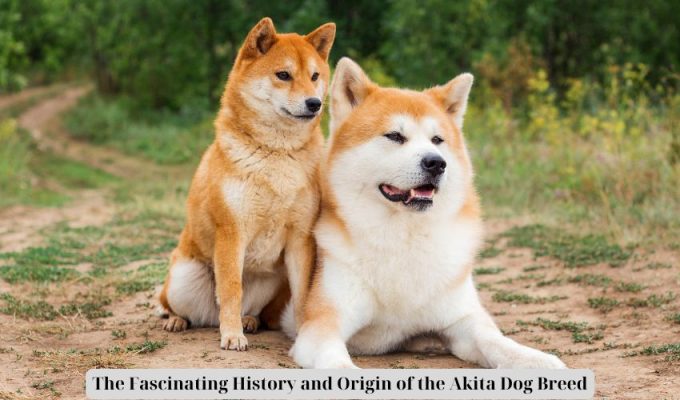Explore the captivating origins of the Akita dog breed in this intriguing historical journey.
Introduction
The Akita is a powerful and muscular breed of working dog that originated in the mountains of northern Japan. In 1931, the Japanese government designated the Akita as a “natural monument” due to its historical significance. Originally employed as a hunting and fighting dog, the Akita is now trained for police and guard work. This breed is characterized by its broad head, erect, pointed ears, and a large curved tail carried over the back or curled against the flank. Akitas are known for their distinct mask and are bred in a variety of colors and markings, including all-white, brindle, and pinto.
The spitz group of dogs, which includes the Akita, is characterized by their wolflike or foxlike head, dense double coat, erect, pointed ears, and tails that curve over their backs. These traits were developed to shield these breeds from the cold, as they originated in cold northern regions such as Alaska and Siberia. The spitz breeds are known for their loyalty, affection, and adventurous nature, but they can also be independent and mischievous. It’s important to note that individual dogs within these breeds may differ in behavior and temperament.
Characteristics of Akitas and Spitz Breeds
– The Akita is a powerful and muscular dog with a broad head, erect, pointed ears, and a large curved tail.
– Akitas are bred in a variety of colors and markings, including all-white, brindle, and pinto.
– Spitz breeds, including the Akita, have a dense double coat that insulates them from cold temperatures.
– These breeds are known for their loyalty, affection, and adventurous nature, but they can also be independent and mischievous.
– Individual dogs within these breeds may differ in behavior and temperament.

Ancient Japanese Origins
The Akita breed has ancient origins in the mountains of northern Japan, where it was employed as a hunting and fighting dog. In 1931, the Japanese government designated the Akita as a “natural monument,” recognizing its historical and cultural significance. This breed has been an integral part of Japanese history and is deeply rooted in the country’s traditions and folklore.
Historical Significance
The Akita’s designation as a “natural monument” by the Japanese government reflects its status as a symbol of loyalty, courage, and strength in Japanese culture. Throughout history, the Akita has been revered for its unwavering loyalty and protective nature, making it a beloved and respected breed in Japan.
- Loyalty and Courage: The Akita has long been celebrated for its loyalty and courage, traits that have been immortalized in Japanese folklore and literature.
- Symbol of Strength: The Akita’s powerful and muscular build has made it a symbol of strength and resilience in Japanese society, further solidifying its status as a revered breed.
- Cultural Significance: The Akita’s role in Japanese history and its designation as a “natural monument” underscore its cultural significance and enduring impact on the country’s heritage.
Evolution of the Akita Breed
The Akita breed has a long and storied history that dates back to ancient Japan. Originally used as hunting and fighting dogs, Akitas were highly valued for their strength, courage, and loyalty. Over time, the breed evolved to become not only a working dog but also a beloved companion and guardian. Through careful breeding and selection, the Akita has developed into the powerful and dignified breed that we know today.
Historical Origins
The Akita’s origins can be traced back to the mountainous regions of northern Japan, where they were initially bred for their hunting and guarding abilities. The breed’s natural strength and protective instincts made them well-suited for these roles, and they quickly gained popularity among the people of Japan. As the breed continued to evolve, it became known for its unwavering loyalty and fierce devotion to its family.
Modern Development
In more recent times, the Akita has transitioned from its traditional roles as a hunting and fighting dog to become a valued member of society. With their intelligence and versatility, Akitas are now trained for police and guard work, showcasing their adaptability and willingness to serve. The breed’s evolution has also seen them become beloved family pets, known for their affectionate nature and protective instincts. Today, the Akita continues to be a symbol of strength, courage, and loyalty.
Akita’s Role in Japanese Society
The Akita has a long and revered history in Japanese society, where it has been highly regarded for its loyalty, courage, and protective nature. In Japan, the Akita is seen as a symbol of good health, happiness, and long life, and it is often given as a gift to new parents or those recovering from illness. The breed is also celebrated in the annual Akita Dog Festival, held in Odate, Japan, where Akitas are honored and showcased.
Traditional Work and Hunting
The Akita’s original role in Japanese society was as a hunting and fighting dog, employed for tracking and capturing game in the mountainous regions of northern Japan. Their strength, agility, and keen sense of smell made them valuable assets for hunters, and their protective instincts also made them effective guard dogs for their owners’ homes and livestock.
Modern Day Role
Today, Akitas in Japan continue to serve as working dogs, often trained for police and guard work. Their natural protective instincts and unwavering loyalty make them well-suited for these roles, and they are valued for their ability to provide security and companionship to their handlers. Additionally, the Akita’s status as a “natural monument” in Japan reflects the deep cultural significance and reverence for the breed within Japanese society.
Introduction to the Akita Breed in the West
The Akita breed has a rich history in its native Japan, but it also has a strong presence in the West. Since Helen Keller brought the first Akita to the United States in 1937, the breed has gained popularity and recognition for its loyalty, strength, and protective nature. Akitas were officially admitted into the show classifications of the American Kennel Club (AKC) in 1973, further solidifying their place in Western culture. With their distinctive appearance and unique personality traits, Akitas have become beloved companions and working dogs in the Western world.
Characteristics of the Akita Breed
Akitas are powerful, muscular dogs with a broad head, erect, pointed ears, and a large curved tail carried over the back or curled against the flank. They come in a variety of colors and markings, including all-white, brindle, and pinto, with a distinct mask around the muzzle. Known for their alert, courageous, and protective nature, Akitas are one-family dogs, devoted to those in their inner circle but often aloof towards strangers. They are calm and not excessively playful as adults, and they may be aggressive towards other dogs. Akitas are independent and strong-willed, making them challenging to train, but they can excel in activities such as agility, obedience, and tracking when properly motivated.
Caring for Akitas in the West
In the Western world, Akitas require regular exercise, mental stimulation, and proper coat care. They enjoy colder weather and snow but are not well suited for hot temperatures. A well-fenced yard is necessary for Akitas, as they are capable jumpers. Regular grooming, including brushing and occasional bathing, is essential for maintaining their double coat. Akitas are prone to certain health conditions such as gastric dilation volvulus, patellar luxation, and hypothyroidism, so regular veterinary check-ups are important to ensure their well-being. Proper diet and exercise are also crucial for the overall health and longevity of Akitas in the West.
Modern Status of the Akita Breed
The Akita breed continues to be a popular and well-respected working dog, known for its loyalty and protective nature. In modern times, Akitas are often trained for police and guard work, as well as participating in various dog sports such as agility, obedience, nose work, and tracking. Their strong-willed nature and independence make them a unique and challenging breed to train and handle, but their alertness and courage make them valuable assets in various working roles.
Challenges and Concerns
Despite their popularity, Akitas are not without their challenges and health concerns. The breed is susceptible to conditions such as gastric dilation volvulus (GDV), patellar luxation, and hypothyroidism. Additionally, their heavy shedding requires regular grooming and coat care, which can be a significant commitment for owners. It’s important for potential Akita owners to be aware of these challenges and to be prepared to provide the necessary care and attention for their dogs.
Popularity and Recognition
The Akita breed has gained recognition and acceptance in various kennel clubs and organizations, including the American Kennel Club (AKC). With their unique blend of strength, intelligence, and loyalty, Akitas continue to be valued and respected members of the working dog community. Their designation as a “natural monument” by the Japanese government further highlights their historical and cultural significance.
Conclusion
In conclusion, the Akita and spitz breeds are both unique and fascinating in their own right. With their origins in cold northern regions, these breeds have developed distinct physical and behavioral characteristics that make them well-suited for harsh climates. Their dense, double coats, pointed ears, and bushy tails are all adaptations that have allowed them to thrive in cold weather. Additionally, their loyalty and protective nature make them excellent companions for those looking for a devoted and vigilant pet.
Furthermore, the debate surrounding breed-specific legislation for dogs such as Akitas is a complex and contentious issue. While some argue that BSL can help prevent dog fighting and the breeding of dangerous dogs, others believe that it is not an effective way to make communities safer. It is important for policymakers to carefully consider the evidence and weigh the potential impact of BSL on both public safety and the well-being of specific dog breeds.
Overall, the Akita and spitz breeds offer a rich history and a range of characteristics that make them both fascinating and unique. Whether as working dogs, loyal companions, or devoted protectors, these breeds continue to capture the hearts of dog enthusiasts around the world. It is important to approach the care and management of these breeds with a thorough understanding of their specific needs and behaviors, and to make informed decisions when it comes to legislation and regulation.
Key Considerations:
– Understanding the unique characteristics and needs of the Akita and spitz breeds
– Evaluating the potential impact of breed-specific legislation on public safety and the well-being of specific dog breeds
– Recognizing the importance of responsible ownership and informed decision-making when it comes to caring for and managing these breeds.
In conclusion, the Akita dog breed originated in Japan and has a long history as a loyal and courageous companion. With their strong and independent nature, they make excellent family pets and have become beloved around the world for their distinctive appearance and devoted nature.




